Digital Camera Market Size
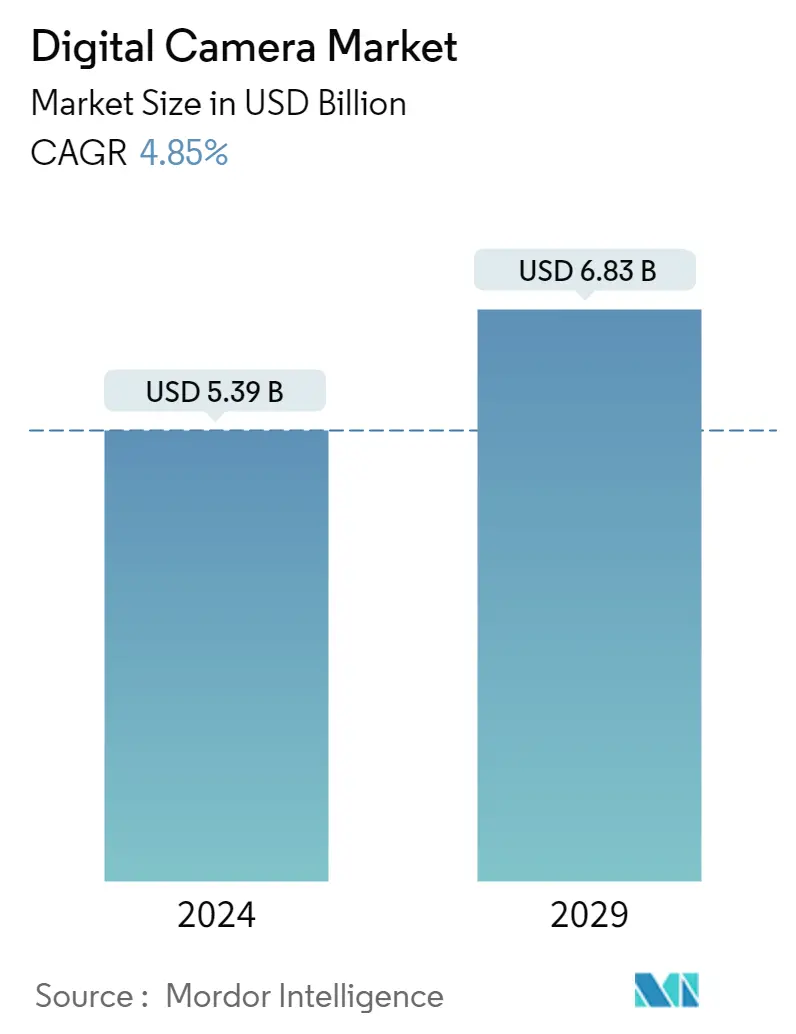
| Study Period | 2019 - 2029 |
| Market Size (2024) | USD 5.39 Billion |
| Market Size (2029) | USD 6.83 Billion |
| CAGR (2024 - 2029) | 4.85 % |
| Fastest Growing Market | Asia-Pacific |
| Largest Market | Asia Pacific |
Major Players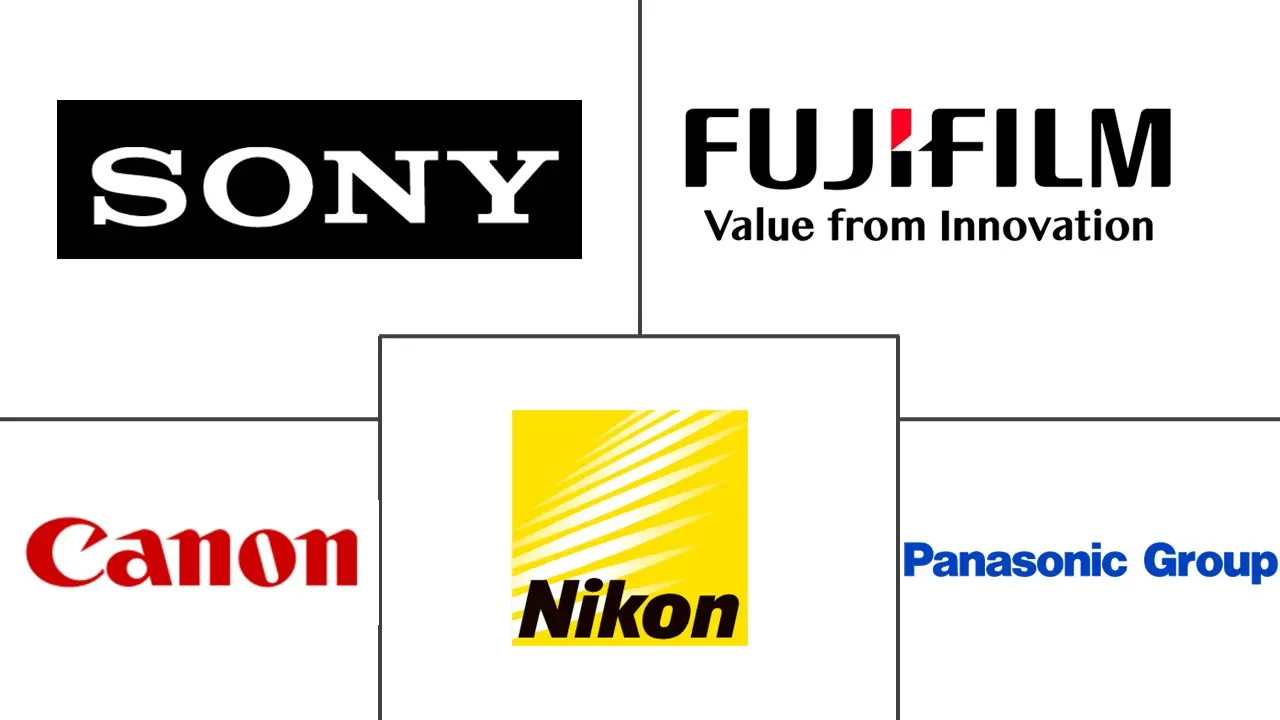
*Disclaimer: Major Players sorted in no particular order |
Digital Camera Market Analysis
The Digital Camera Market size is estimated at USD 5.39 billion in 2024, and is expected to reach USD 6.83 billion by 2029, growing at a CAGR of 4.85% during the forecast period (2024-2029).
The market is studied based on the revenue generated from the sale of digital cameras across the world.
- The growth rate of the global digital camera market is expected to decline over the forecast period, owing to shifting consumer preference toward smartphone cameras. Global digital camera shipments have been witnessing a downfall in sales in the last decade. Most of the major digital camera manufacturers have also recorded a decline and fluctuating sales in the past few years.
- Numerous types of digital cameras were available, and the marketplace was rather crowded. However, the manufacturers, Nikon and Canon, created the full frame camera for a niche customer base that desired quicker shutters, better resolution, and more clarity. These were for professionals, such as sports and wedding photographers, who earned a living from photography, and a lousy shot could negatively affect their business.
- However, the recent advancements in technology and the growing number of digital photography platforms and social media platforms have created new opportunities for the vendors in the market studied. The numerous product launches with feature upgrades in recent years, along with newer payment methods and camera services, are expected to aid the growth of the market studied. Major players, such as Nikon, Sony, Canon, and Fujifilm, are introducing innovations in the field of mirrorless cameras and are highly optimistic about their adoption.
- The quality of smartphone cameras has improved dramatically in recent years. Most individuals no longer need to carry or purchase a dedicated camera. While photo enthusiasts and professionals are expected to obtain superior results with high-end lenses and cameras, current smartphones produce images that are certainly enough for the average consumer's needs.
- Various travel bans imposed across different countries during COVID-19 created a loss of income for professional photographers, leading to the lack of resources to purchase new models of cameras. This had decreased the demand for digital camera production. However, after the pandemic, the market is growing rapidly due to the launch of new products. This growth is further supported by the lifitng of travel bans, providing the opportunity to expand the market.
Digital Camera Market Trends
This section covers the major market trends shaping the Digital Camera Market according to our research experts:
Increase in Sales of Mirror-less Lens is Driving the Market
- The growing use of mirrorless cameras has increased innovations to make the devices more user-friendly. Furthermore, businesses have invested heavily in developing unique and improved products. For instance, Fujifilm claimed that the company expects the demand for mirrorless cameras to surpass DSLRs in the near future. The company also asserted that mirrorless cameras have already surpassed DSLRs in global markets, such as Europe and the United States. With these tendencies, the demand for mirrorless cameras would likely grow throughout the forecast period.
- The development in progress and innovation in mirrorless cameras are expected to drive the demand for mirror-less lenses in the future. Major market players have been spending heavily on camera technology to provide unique photography solutions. For example, Fujifilm, one of the market's leading companies, offers the Fujifilm X-T4, an all-rounder mirrorless camera. The camera features an APS-C sensor along with a 26.1 MP resolution. It boasts 425-point autofocus.
- Nikon's Y-o-Y revenue grew to JPY 64.3 billion (USD 460.3 million) in the first two-quarters of FY2022 due to an expansion in the sales mix with a move to pro/hobbyist models aided by the sales of the new mirrorless camera. The sales of mirrorless cameras are expected to rise in the forecast period. This is expected to aid the increase in the demand for mirrorless lenses.
- Furthermore, key manufacturers' recent breakthroughs and product launches are expected to fuel demand for mirrorless lenses. For example, in September 2022, Nikon released the NIKKOR Z 17-28mm f/2.8, an ultrawide-angle zoom lens suitable for full-frame/FX-format mirrorless cameras that utilize the Nikon Z mount.
- Moreover, recent advancements have enabled key players to provide mirrorless cameras using full-frame sensors. Sony Electronics Inc., for instance, introduced the Alpha 7R V (model ILCE-7RM5) as a part of the latest R series cameras in its famed range of Alpha mirror-less interchangeable lens cameras in October 2022. The Alpha 7R V features Sony's maximum resolution image sensor in an Alpha camera, in addition to a new AI processing unit focused on artificial intelligence-based image recognition - and the potent BIONZ XRTM image analysis engine - among the first in the "R" full-frame lineup. The combination of this processor and the high-resolution sensor allows significant advances in subject capture and recognition for both still and video photos.
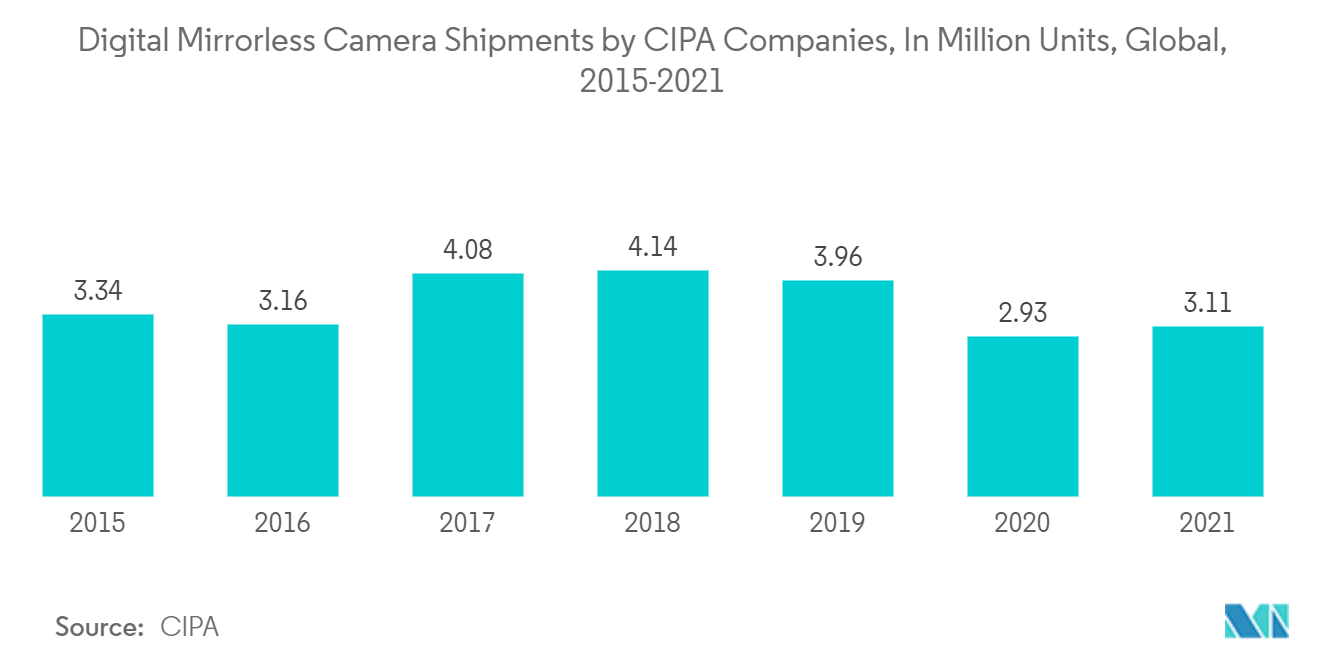
Asia-Pacific to Witness Fastest Growth
- The current photography trend in the Asia-Pacific fuels the desire for digital cameras. Photography has grown more user-friendly and economical, supporting the region's demand for digital cameras.
- With the existence of significant and major companies, such as Sony Corporation, Canon Inc., Panasonic Corporation, and Nikon Corporation, Asia-Pacific is expected to be one of the prominent regions in the global market. These companies intend to improve their diversified imaging techniques based on their core optical technology to create an electro-optical system (EOS) that provides new avenues of capturing images to meet the requirements of an increasingly diverse customer base and to encourage the ever-growing video and photo culture.
- The Camera & Imaging Products Association in Japan (CIPA) anticipates the production of 5.29 million mirrorless and DSLR devices in calendar 2022, whereas Nikon forecasts 5.1 million between April 2022 and March 2023.
- Furthermore, the rising number of destination and big wedding events in the Asia-Pacific region has resulted in a boom in demand for wedding photography, significantly impacting the digital camera market.
- The region's increased disposable income and enthusiasm for photography are also projected to benefit the industry. In addition, conferences specialized in lenses, cameras, and imaging accessories, such as the International Camera Fair, were hosted in India in September 2022. Such gatherings are likely to fuel the digital camera market.
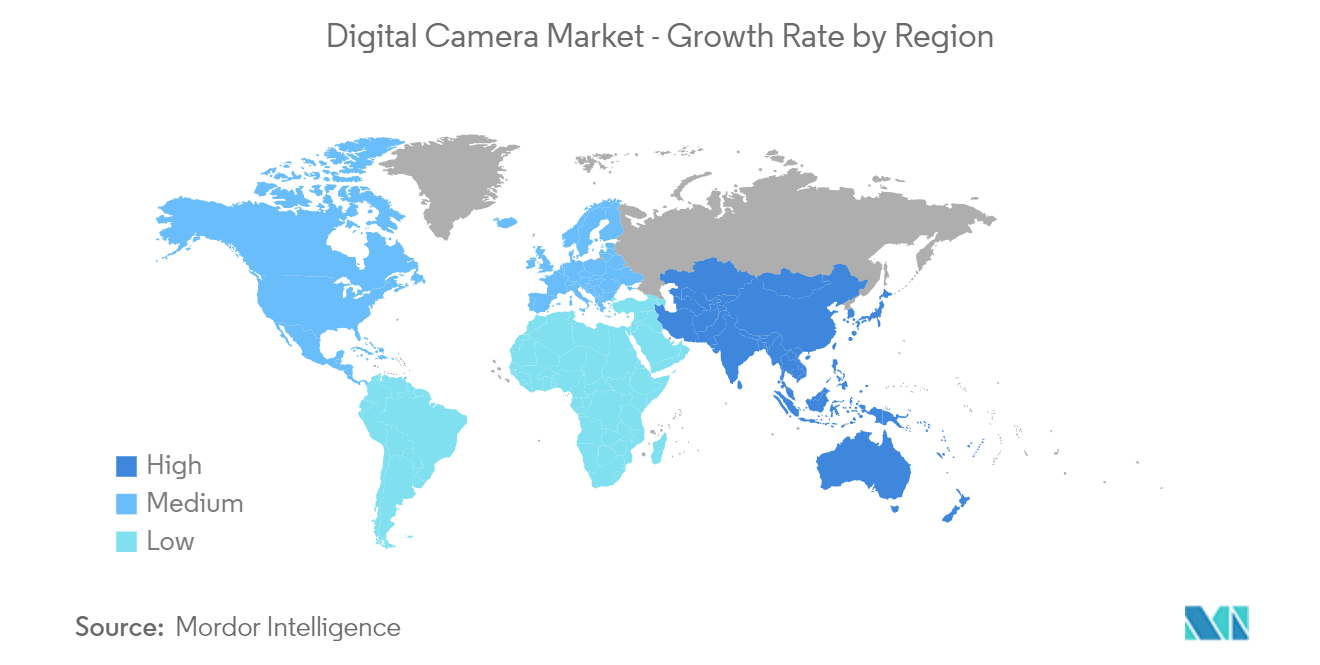
Digital Camera Industry Overview
The digital camera market is highly competitive due to the presence of players such as Nikon Corporation, Sony Corporation, and Canon Inc, amongst others. Although the market is facing huge competition from the smartphone market, the players in the market are focusing on product launches to target niche customer bases.
In September 2022, Canon USA, Inc. announced the release of four professional camcorders, the XA65, XA60, XA75, and XA70, as well as the VIXIA HF G70 camcorder. The new camcorders are suitable for various applications, including documentaries, corporate events, and education. These models provide exceptional performance, capturing spectacular 4K resolution content, HD UVC Streaming through USB-Ci, and superior focusing and facial detection capability. They all offer MP4 and On-Screen Display (OSD) recording, with the four professional camcorders supporting XF-AVC recording for broadcast purposes. Canon has also released a software update for the XF605 camcorder.
In September 2022, Nikon Corporation unveiled the NIKKOR Z 17-28mm f/2.8, an ultra-wide-angle zoom lens compatible with full-frame/FX-format mirrorless cameras that use the Nikon Z mount. The NIKKOR Z 17-28mm f/2.8 is an ultrawide-angle zoom lens with a fast constant maximum aperture of f/2.8 that spans the focal length range of 17 to 28 mm. This lens provides exceptional portability with a total length of around 101 mm*1 and a weight of about 450 g, besides providing a superior optical performance.
Digital Camera Market Leaders
-
Nikon Corporation
-
Canon, Inc.
-
Panasonic Corporation
-
Fujifilm Holdings
-
Sony Corporation
*Disclaimer: Major Players sorted in no particular order
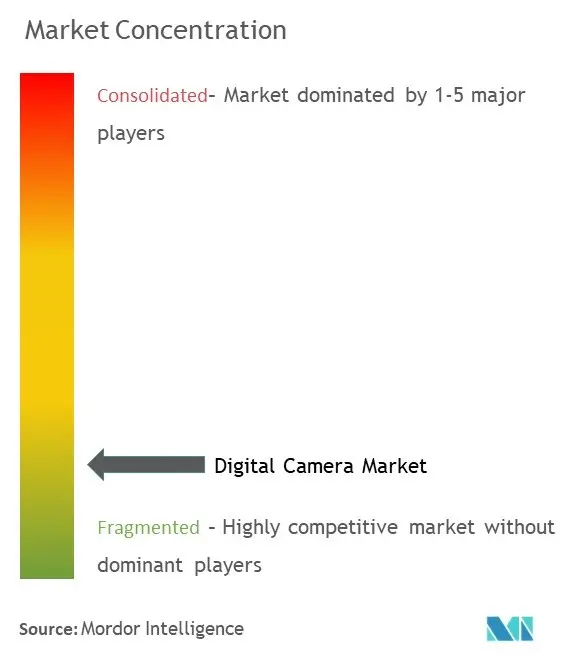
Digital Camera Market News
- October 2022 - Fujifilm announced a partnership with Adobe to produce a new mirrorless digital camera firmware, "FUJIFILM X-H2S" (X-H2S), in spring 2023, which would deliver the world's first native Camera to Cloud (C2C) connectivity for mirrorless digital cameras, driven by Frame.io. At the same time, the firmware for the "FT-XH" file transmitters will also be launched.
- September 2022 - Canon U.S.A., Inc., a significant provider of digital imaging solutions, announced the addition of a suite of products to its cinema and broadcast offerings in response to user demand. Canon's latest 8K CINE-SERVO lens for a wide range of productions is the CINE-SERVO 15-120mm T2.95-3.95 EF/PL (CN8x15 IAS S); the EU-V3, a modular expansion unit for the EOS C500 Mark II and EOS C300 Mark III cameras; a Cinema EOS firmware update; and the DP-V2730i, a 27-inch 4K professional reference display that may seamlessly fit into workflows of broadcasters and filmmakers.
- September 2022 - FUJIFILM North America Corporation announced the release of the new FUJINON XF56mmF1.2 R WR (XF56mmF1.2 R WR) weather-resistant, mid-telephoto prime lens, the latest in a line of interchangeable lenses designed for the FUJIFILM X Series of mirrorless digital cameras. The FUJINON XF56mmF1.2 R WR is the successor to the popular FUJINON XF56mmF1.2 R lens and now boasts considerable improvements from that earlier model in minimum focusing distance, image-resolving capability, and gorgeous rendering of out-of-focus background.
Digital Camera Market Report - Table of Contents
1. INTRODUCTION
- 1.1 Study Assumptions and Market Definition
- 1.2 Scope of the Study
2. RESEARCH METHODOLOGY
3. EXECUTIVE SUMMARY
4. MARKET INSIGHT
- 4.1 Market Overview
-
4.2 Industry Attractiveness - Porter's Five Forces Analysis
- 4.2.1 Bargaining Power of Suppliers
- 4.2.2 Bargaining Power of Consumers
- 4.2.3 Threat of New Entrants
- 4.2.4 Threat of Substitutes
- 4.2.5 Intensity of Competitive Rivalry
- 4.3 Industry Value Chain Analysis
- 4.4 Assessment of the Impact of COVID-19 on the Market
5. MARKET DYNAMICS
-
5.1 Market Drivers
- 5.1.1 Anticipated Increase in Sales of Mirror-less Lens
- 5.1.2 Demand for Specialized Products from Niche Customer Base
-
5.2 Market Challenges
- 5.2.1 Strong Competition from Smartphones with Advanced Features
- 5.2.2 Growing Trend Towards Camera Rentals
- 5.3 Key Technological Innovations - Mirrorless Lens and Accessories
- 5.4 Historical Trend Analysis of Digital Camera Sales (1999-2021)
6. MARKET SEGMENTATION
-
6.1 By Lens Type
- 6.1.1 Built-in
- 6.1.2 Interchangeable
-
6.2 By Camera Type
- 6.2.1 Compact Digital Camera
- 6.2.2 DSLR
- 6.2.3 Mirrorless
-
6.3 By End-user
- 6.3.1 Pro Photographers
- 6.3.2 Prosumers
- 6.3.3 Hobbyists
-
6.4 By Geography
- 6.4.1 North America
- 6.4.2 Europe
- 6.4.3 Asia-Pacific
- 6.4.4 Latin America
- 6.4.5 Middle East & Africa
7. COMPETITIVE LANDSCAPE
- 7.1 Vendor Market Share Analysis
-
7.2 Company Profiles
- 7.2.1 Nikon Corporation
- 7.2.2 Canon Inc.
- 7.2.3 Panasonic Corporation
- 7.2.4 Fujifilm Holdings Corporation
- 7.2.5 Sony Corporation
- 7.2.6 Eastman Kodak Company
- 7.2.7 OM Digital Solutions Corporation
- 7.2.8 Sigma Corporation
- 7.2.9 Leica Camera AG
- 7.2.10 Victor Hasselblad AB
- *List Not Exhaustive
8. INVESTMENT ANALYSIS
9. FUTURE OF THE MARKET
** Subject To AvailablityDigital Camera Industry Segmentation
The global digital camera market covers the revenue generated from the shipment value of digital cameras worldwide. The study tracks the demand for the digital camera market based on lens type, camera type, end-users, and geography. The market also covers the major micro- and macro-economic factors impacting the growth of the market studied in terms of drivers and restraints.
The scope of the study focuses on the market analysis of digital cameras worldwide. Market sizing encompasses the value of the total number of shipments globally. The study also tracks the key market parameters, underlying growth influencers, and major vendors operating in the industry, expected to support the market estimations and growth rates over the forecast period. The study further analyzes the overall impact of COVID-19 on the ecosystem. The report's scope encompasses market sizing and forecast for segmentation by lens type, camera type, end-users, and geography. The market sizes and forecasts are provided in terms of value (USD million) for all the above segments.
| By Lens Type | Built-in |
| Interchangeable | |
| By Camera Type | Compact Digital Camera |
| DSLR | |
| Mirrorless | |
| By End-user | Pro Photographers |
| Prosumers | |
| Hobbyists | |
| By Geography | North America |
| Europe | |
| Asia-Pacific | |
| Latin America | |
| Middle East & Africa |
Digital Camera Market Research FAQs
How big is the Digital Camera Market?
The Digital Camera Market size is expected to reach USD 5.39 billion in 2024 and grow at a CAGR of 4.85% to reach USD 6.83 billion by 2029.
What is the current Digital Camera Market size?
In 2024, the Digital Camera Market size is expected to reach USD 5.39 billion.
Who are the key players in Digital Camera Market?
Nikon Corporation, Canon, Inc. , Panasonic Corporation, Fujifilm Holdings and Sony Corporation are the major companies operating in the Digital Camera Market.
Which is the fastest growing region in Digital Camera Market?
Asia-Pacific is estimated to grow at the highest CAGR over the forecast period (2024-2029).
Which region has the biggest share in Digital Camera Market?
In 2024, the Asia Pacific accounts for the largest market share in Digital Camera Market.
What years does this Digital Camera Market cover, and what was the market size in 2023?
In 2023, the Digital Camera Market size was estimated at USD 5.14 billion. The report covers the Digital Camera Market historical market size for years: 2019, 2020, 2021, 2022 and 2023. The report also forecasts the Digital Camera Market size for years: 2024, 2025, 2026, 2027, 2028 and 2029.
What are the growth opportunities in the Digital Camera Market?
The growth opportunities for the Digital Camera Market are: a) Rising demand for mirrorless cameras b) Growing trend of photography as a hobby c) Increasing use of cameras in various industries
What are the key drivers of the Digital Camera Market?
Key factors driving the Digital Camera Market are: a) Continuous advancements in technology b) Increasing demand for high-quality imaging devices c) Rising popularity of photography among consumers
Digital Camera Industry Report
The digital camera market is undergoing a significant transformation, fueled by advancements in digital camera technology and evolving consumer preferences. Manufacturers are innovating to meet the demand for lightweight, high-resolution cameras, focusing on enhancing lens types, sensing technology, and applications for both personal and professional use. The shift towards single-reflex and interchangeable lens cameras, known for their versatility and superior image quality, is notable. The integration of Complementary Metal-Oxide-Semiconductor (CMOS) technology has been key in achieving faster processing speeds and improved sensitivity, propelling market growth. Digital cameras find diverse utility across industries such as sports media, healthcare, and film production, despite competition from alternative imaging devices. The continuous technological upgrades and the development of Internet of Things (IoT)-enabled devices signal a promising future for the market, particularly in professional settings and the travel and tourism sector. According to Mordor Intelligence™ Industry Reports, the digital camera market's share, size, and revenue growth are comprehensively analyzed, offering a forecast outlook and historical overview. For detailed insights, a free report PDF download is available, highlighting the pivotal role of digital camera technology and manufacturers in shaping the market's trajectory.



